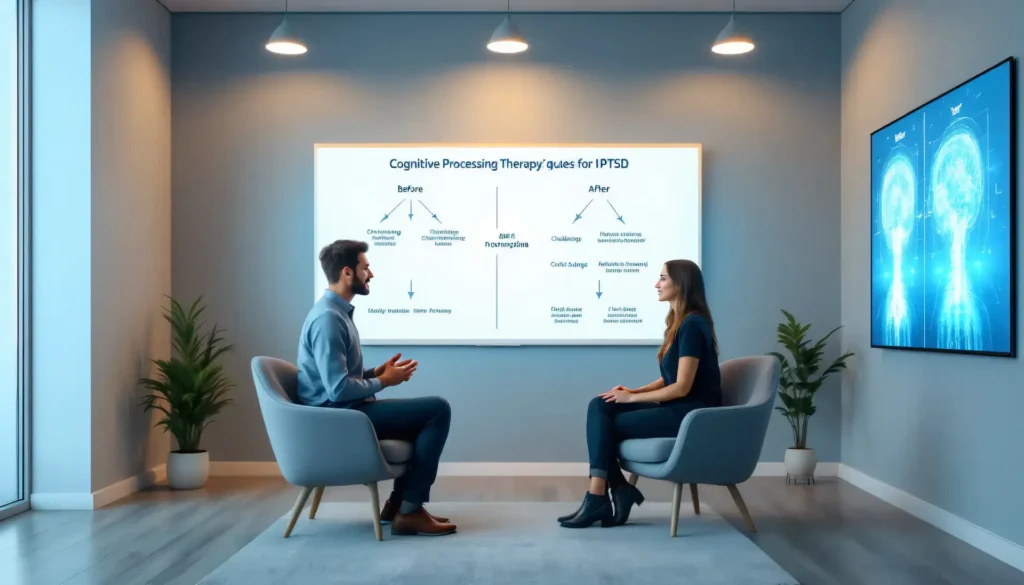Looking for scientifically-backed treatments for PTSD? In this article, we explore evidence-based treatments for PTSD, explaining why they work and what research says about their effectiveness. From Prolonged Exposure to Cognitive Processing Therapy, discover proven options you can rely on.
Key Takeaways
- PTSD can significantly impair daily functioning and social interactions, necessitating early recognition and intervention for effective treatment.
- Evidence-based therapies for PTSD include Prolonged Exposure Therapy, Cognitive Processing Therapy, and Eye Movement Desensitization and Reprocessing, each demonstrating substantial effectiveness in alleviating symptoms.
- Gender-specific treatment approaches, such as those implemented at The Rose House, acknowledge the unique trauma experiences faced by women, enhancing therapeutic engagement and recovery outcomes.
Understanding PTSD and Its Impact
Posttraumatic stress disorder can arise after an individual has experienced or been a witness to life-threatening traumatic events. Although many people encounter trauma, it doesn’t always result in the development of posttraumatic stress disorder. The possibility of developing this mental health condition is heightened by factors such as previous exposure to traumatic events, existing psychological issues, and insufficient social support.
Those suffering from PTSD may experience various symptoms, including persistent upsetting memories or nightmares related to their traumatic event(s). Frequently observed are also avoidance behaviors where those affected might actively evade places, activities, or persons that could trigger memories of the trauma.
The ramifications of PTSD reach far beyond personal impact. They impinge on one’s capacity for daily functioning. Such consequences can lead to difficulties with social engagements, reduced work productivity, and less enjoyment derived from everyday experiences. Untreated chronic effects have the potential to escalate into severe, debilitating mental health conditions. Group therapy allows individuals to connect with others who have had similar traumatic experiences, building a sense of shared understanding and support.
Acknowledgement of PTSD’s significant impact plays a vital role in securing effective treatment. Early identification and comprehension of its pervasive influence underscore the critical need for immediate intervention efforts when addressing posttraumatic stress symptoms.
Diagnostic Criteria for PTSD
The Fifth Edition of the Diagnostic and Statistical Manual of Mental Disorders (DSM-5) categorizes PTSD under Trauma- and Stressor-Related Disorders, acknowledging both stress disorder PTSD and traumatic stress disorder. This update reflects a more nuanced understanding of trauma’s intricate consequences. The criteria for diagnosing PTSD include enduring a traumatic event coupled with symptoms across four distinct groups: intrusive recollections or flashbacks, avoidance behaviors, negative changes in thought patterns and emotional state, along with shifts in arousal levels and reactivity.
Intrusive manifestations may involve unsettling memories or vivid reliving of experiences. Conversely, avoidance denotes shunning elements that recall the traumatic incident. Cognitive alterations typically encompass pervasive adverse assumptions about oneself or surroundings, while modifications in arousal might present as increased irritability or excessive vigilance against potential threats. Such responses are often intensified by the presence of a distressing traumatic memory.
DSM-5 delineates a dissociative variant of PTSD marked by phenomena like depersonalization—a detachment from one’s self—or derealization—the sensation that one’s environment is unreal—which compound an individual’s struggle with experiencing trauma-related disorders.
For an accurate determination of PTSD to be made, these conditions must not only continue beyond one month, but also inflict significant impediments on routine life activities—this correlation being indicative of the gravity associated with post-traumatic symptom intensity—and underscores why evaluating comprehensively is crucial when developing intervention strategies tailored to each person affected by such disorders.

Prolonged Exposure Therapy (PE)
Prolonged Exposure Therapy (PE) is a specialized form of cognitive behavioral therapy crafted to assist individuals in becoming accustomed to their traumatic memories and in reducing behaviors linked with avoidance. PE can be up to 8 to 15 sessions and includes psychoeducation, breathing retraining, in vivo exposure, and imaginal exposure. Through systematic exposure to these trauma-related memories during PE, the goal is to lessen the associated emotional distress.
This therapeutic approach typically spans between 8 and 15 sessions wherein patients partake in both imaginal and in vivo exposure methods. In-vivo exposure requires confronting fear-inducing yet safe real-life scenarios, whereas imaginal exposure involves mentally revisiting the traumatic event within a secure setting managed by a therapist. This two-pronged strategy facilitates patient processing of trauma and its incorporation into their wider life story.
Empirical studies have affirmed PE’s efficacy, indicating that six years post-treatment, approximately 83% of those treated no longer fit PTSD diagnostic criteria. These findings emphasize not only PE’s capacity for delivering enduring relief from PTSD symptoms but also showcase the significant impact that effective psychological treatments can have on recovery from trauma.

Cognitive Processing Therapy (CPT)
The American Psychiatric Association (APA) and the Department of Veterans Affairs/Department of Defense (VA/DoD) both advocate for Cognitive Processing Therapy (CPT) as an effective treatment option for PTSD. As a specialized form within the domains of cognitive behavioral therapy and cognitive therapy, CPT targets persistent negative thought patterns that contribute to the continuation of PTSD symptoms.
At its core, CPT is structured around four main pillars: instructing patients about PTSD itself, guiding them through processing their traumatic event(s), aiding in reframing detrimental thoughts, and navigating central issues related to trauma, such as safety and trust. Cognitive Processing Therapy (CPT) is a form of trauma-focused cognitive behavioral therapy (TF-CBT) that emphasizes challenging and modifying negative thoughts related to trauma. The goal is to assist individuals in recognizing and critically evaluating ‘stuck points’, which are obstructive beliefs impeding their path to recovery.
Incorporated into this therapeutic model are written exercises called trauma accounts. These narrative assignments play a crucial role by facilitating clients’ engagement with their traumatic experiences in detail. Typically conducted over 8-14 sessions, CPT delves into significant thematic areas including safety, empowerment, control dynamics, self-worth perception, and relational intimacy.
Eye Movement Desensitization and Reprocessing (EMDR)
Introduced in 1987 as a method for treating PTSD, Eye Movement Desensitization and Reprocessing (EMDR) is grounded in the Adaptive Information Processing model. It employs an eight-phase protocol that centers on altering the way trauma memories are processed by using bilateral stimulation methods like eye movements, auditory tones, or taps. EMDR has been recommended as a first-line treatment for PTSD by both the APA and the VA/DoD based on a large body of research supporting its effectiveness.
In contrast to other treatments that concentrate on traumatic experiences, EMDR does not necessitate extensive verbal recounting of traumatic events, nor does it involve homework tasks. The therapy encourages clients to mentally engage with distressful recollections while simultaneously receiving bilateral stimulation, which aids in diminishing both the intensity and emotional charge associated with these memories through techniques that do not directly focus on the trauma itself.
Typically administered over 6 to 12 sessions at a frequency of once or twice per week, EMDR offers a structured therapeutic process proven effective in alleviating the impact of traumatic memories. This has established its standing as a valuable intervention for individuals suffering from PTSD.
Cognitive Behavioral Therapy (CBT) for PTSD
Cognitive Behavioral Therapy (CBT) is recognized as a highly effective method for addressing PTSD, with an emphasis on the trauma-focused variant of CBT being particularly recommended. Typically, this form of therapy includes 8 to 12 weekly sessions that range from one hour to an hour and a half in length and incorporate various treatments designed to address PTSD symptoms.
The primary goal of CBT in treating PTSD is to transform negative thought patterns and behaviors that amplify distress and hinder functioning among sufferers. Through cognitive restructuring within these sessions, individuals are guided through processes aimed at pinpointing inaccuracies in their thinking that perpetuate their symptoms. Cognitive therapy for PTSD includes modifying excessively negative appraisals and correcting autobiographical memory disturbances.
CBT equips people with practical coping mechanisms intended to help them effectively handle their PTSD symptoms and reclaim autonomy over their existence. Acquiring such strategies is vital for enduring recovery and enhanced daily performance.
Narrative Exposure Therapy (NET)
Narrative Exposure Therapy (NET) has proven to be highly effective for those grappling with complex trauma, which is commonly encountered in community environments. It is especially recognized for its beneficial applications among refugee populations and aids them in constructing a coherent narrative of their lives.
During the therapy sessions, individuals are guided to chronicle an extensive history of their life events that encompasses both traumatic incidents and positive moments. Such a comprehensive approach serves to embed the trauma within the wider framework of their life story, thus diminishing its emotional toll.
Upon completion of NET, patients often produce a written autobiography—a concrete testament to their therapeutic journey. This document not only embodies the progress achieved through therapy but also imparts a substantial sense of achievement that can significantly motivate individuals moving forward.
Brief Eclectic Psychotherapy
Brief Eclectic Psychotherapy (BEP) targets the distressing emotions of shame and guilt that often stem from traumatic events. It combines elements of cognitive-behavioral methods with psychodynamic concepts to strengthen the therapist-client connection and promote emotional healing.
Composed of 16 sessions, each ranging from 45 minutes to an hour, usually on a weekly basis, this therapy tackles both cognitive and emotional facets of trauma. BEP provides a well-rounded method for treating PTSD by helping people work through their traumatic experiences towards recovery.
Pharmacological Treatments for PTSD
Selective Serotonin Reuptake Inhibitors (SSRIs) like paroxetine and sertraline are frequently prescribed for the pharmacological treatment of PTSD, with both drugs being endorsed by the FDA specifically for this purpose. By modulating serotonin levels in the brain, these medications can mitigate symptoms of PTSD and may be used alongside other treatments. Ongoing research into PTSD treatment continues to shed light on how effective these drugs truly are.
Additional pharmaceutical options that have been deemed effective in treating PTSD include fluoxetine as well as venlafaxine—the latter doubling as a serotonin and norepinephrine reuptake inhibitor at increased doses. These medicines have shown considerable effectiveness in diminishing PTSD symptoms when administered according to medical guidelines.
While topiramate has shown some potential in reducing symptoms associated with PTSD, its adverse effects could discourage widespread recommendation. The variability seen among individuals’ reactions to various medications tailored for alleviating PTSD underscores the importance of creating customized treatment regimens to achieve optimal results.
It’s important not to rely solely on drug therapies. Incorporating psychological interventions into a patient’s regimen is vital for a more holistic approach to managing their condition. An integrated method addressing both mental health concerns and physiological needs provides comprehensive support essential for those undergoing treatment for post-traumatic stress disorder (PTSD).

Challenges in Treating PTSD
Although there are treatments for PTSD that have been proven to work, research from real-world settings has found that more people stop participating in these top-of-the-line therapies than the number who drop out during randomized controlled trials. In broad applications of these therapies, over half of the participants tend not to complete treatment, with a small fraction sticking it out through the recommended therapy sessions.
Factors specific to patients play a role in this high attrition rate. Co-occurring substance abuse and more intense PTSD symptoms make it difficult for those affected to commit to and reap the benefits of therapy fully.
How effective patients believe different treatment methods are and how comfortable they feel within therapeutic environments greatly impact their choice, either to keep going or quit. As such, many look toward alternative forms of help which might be less demanding, causing them, often times, not to get enough evidence due to discontinuity between patient desires during monitored evaluations against rigidly structured evidence-based practices.
Concerns among healthcare providers about possible negative reactions, along with their own skepticism regarding established treatments, can obstruct the delivery of successful interventions for PTSD. Practicalities like traveling issues, financial limitations, and conflicting schedules also pose substantial obstacles, causing individuals undergoing treatment to abandon the process prematurely.
To tackle these issues adequately requires an all-encompassing strategy that takes into account both sides (factors involving the patient as well as clinician) together with any practical impediments towards fostering better involvement rates, thus enhancing overall results within PTSD care services.
The Rose House: A Specialized Facility for Women
At The Rose House, treatment for trauma is tailored specifically for women, providing an environment that nurtures their path to healing. This women-exclusive setting cultivates a space where safety and community are paramount to the recovery process.
The cornerstone of rehabilitation at The Rose House lies in creating a supportive network amongst its residents. Women embarking on their journey towards healing have the opportunity to bond with one another, creating mutual support systems. By addressing all aspects of well-being – psychological, emotional, physical, spiritual, and cognitive – this comprehensive approach ensures individualized care.
Situated in Lafayette, Colorado. The Rose House stands out as one of the few residential mental health facilities focusing exclusively on women’s needs across America. It offers specialized programs designed to tackle addiction alongside primary mental health challenges and disorders occurring simultaneously.

Trauma-Focused Care at The Rose House
At The Rose House, the approach to mental health care prioritizes client safety, empowerment, and collaborative practices. This acknowledges trauma’s deep-seated role in the healing process. The environment is purposefully crafted as a secure space where women can engage with their trauma-focused treatment within a context that emphasizes intense attention to traumatic experiences.
Women experiencing acute stress disorder following trauma benefit significantly from early intervention with both psychological and pharmacological treatments tailored to their unique experiences and needs. At The Rose House, we integrate evidence-based approaches like present-centered therapy alongside trauma-focused modalities, ensuring our treatment plans align with the latest clinical practice guidelines while recognizing that healing is a deeply personal journey requiring both professional expertise and compassionate human connection.
The emphasis on personalized care forms the bedrock of therapy at The Rose House. It takes into consideration every woman’s distinct personal journey through trauma and history, facilitating highly specific therapeutic strategies aimed at alleviating both psychological distress and physical manifestations associated with past traumas.
Recognizing that women frequently encounter unique forms of trauma, such as interpersonal violence requires specialized therapeutic techniques tailored just for them. Gender-specific programming paves the way for more profound discussions centered around their individual traumas while also tackling various societal and cultural hurdles they may confront.
Sustained backing for PTSD sufferers involves creating an organized living situation conducive to fostering beneficial lifestyle habits and coping skills at The Rose House. Aftercare offerings commonly extend to one-on-one therapy sessions, group support interactions, and consistent follow-ups with a mental health professional—services designed to provide ongoing assistance as individuals transition back into everyday life activities.
Benefits of Gender-Specific Treatment
The Rose House is aware that women encounter distinct challenges requiring specialized treatments tailored to their needs. The provision of a gender-specific treatment setting substantially elevates the levels of comfort and safety for women, fostering greater participation in therapeutic activities.
By merging individualized strategies with enhanced ease, there is a notable improvement in recovery results for women grappling with PTSD. Evidence indicates that recovery centers dedicated to women and gender-specific therapies yield higher levels of commitment and success.
Ensuring that the particular requirements of women are met allows The Rose House to deliver care that is both highly effective and imbued with empathy.
Integrative Approach to PTSD at The Rose House
At The Rose House, a multifaceted treatment regimen is deployed to address the complex needs of women suffering from PTSD. This method merges various validated therapies and includes physical activity, hands-on therapeutic experiences, and inventive therapy modalities to support healing processes.
To aid in emotional expression and trauma resolution for these women, creative therapy methods like art therapy and storytelling therapy are employed. Equine Therapy offers an innovative approach by using interactions with horses to foster trust-building and enhance emotional insight.
The facility acknowledges the intricate relationship between trauma histories and substance dependence by offering integrated mental health care that encompasses addiction treatment services. By adopting this all-encompassing strategy toward recovery, The Rose House endeavors to nurture every aspect of a woman’s health for thorough rehabilitation outcomes.
Long-Term Support and Aftercare
At The Rose House, the emphasis on long-term support and aftercare is a critical aspect of the recovery journey. To help manage triggers effectively, individuals are equipped with essential therapy methods and coping strategies along with continuous guidance and well-organized environments conducive to healthy living.
Incorporated into the rehabilitation process are vital elements such as regular physical activity, dietary education, and participation in community service activities. These not only nurture a sense of purpose but also foster connection while promoting healthy habits that align with sustained recovery objectives.
As clients approach their program’s conclusion, they formulate a relapse prevention strategy to encapsulate their acquired knowledge while honoring their achievements. This strategic plan stands as an instrumental resource in preserving sobriety and handling possible challenges ahead.
The provision of unwavering assistance paired with orderly surroundings plays an indispensable role in achieving enduring recuperation. Through its extensive aftercare services, The Rose House commits to aiding each woman under its care by providing her with all the necessary tools for maintaining progress towards meaningful, lasting recovery success.
Summary
To summarize, treatments grounded in scientific research, like Prolonged Exposure Therapy, Cognitive Processing Therapy, and Eye Movement Desensitization and Reprocessing, are highly successful in diminishing the symptoms of PTSD and aiding individuals on their path to recovery. These therapeutic approaches, complemented by medicinal strategies and all-encompassing methods, provide encouragement and pathways to healing for those grappling with PTSD.
The Rose House serves as a prime example of these evidence-based therapies being put into practice. It offers women a secure environment conducive to recovering from traumatic experiences. By tailoring treatment specifically for women and amalgamating various therapy techniques, The Rose House delivers care that is both holistic and empathetic.
Although navigating through PTSD recovery can be daunting, it becomes manageable with adequate support systems paired with effective treatments. As such facilities demonstrate—particularly The Rose House—for women who aspire to triumph over trauma-related challenges, there is a resilient promise for not just recuperation but also flourishing well-being.
Frequently Asked Questions
PTSD, or Post Traumatic Stress Disorder, is a mental health condition that can arise after experiencing or witnessing traumatic events like combat, abuse, or serious accidents. It reflects the profound impact that such experiences can have on an individual’s psychological well-being.
Common symptoms of PTSD include intrusive memories, flashbacks, avoidance of reminders, negative mood changes, and difficulties with sleep.
These symptoms significantly impact daily functioning and quality of life.
PTSD is diagnosed using the DSM-5 criteria, which require a person to have experienced a traumatic event and to display symptoms in four categories: intrusive symptoms, avoidance behaviors, negative changes in cognition and mood, and alterations in arousal and reactivity.
This comprehensive approach ensures a thorough evaluation of the individual’s experiences and symptoms.
Evidence-based therapies proven to be effective in treating PTSD include Prolonged Exposure Therapy, Cognitive Processing Therapy, Eye Movement Desensitization and Reprocessing (EMDR), and various forms of Cognitive Behavioral Therapy.
In conjunction with these therapeutic approaches, pharmacological treatments—specifically Selective Serotonin Reuptake Inhibitors (SSRIs)—may offer additional relief for individuals coping with PTSD.
Opting for The Rose House for the treatment of PTSD offers advantages because it utilizes a gender-specific strategy, creating an environment that is secure and conducive to support specifically tailored for women.
The holistic approach employed by their integrative method incorporates therapies backed by scientific evidence alongside comprehensive wellness care, delivering a thorough and empathetic journey toward recovery.








